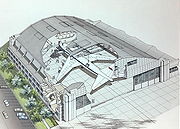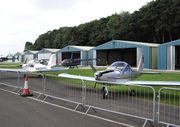Hangar

A hangar is a closed structure to hold aircraft and/or spacecraft in protective storage. Most hangars are built of metal, but some materials like wood and concrete are other materials used. The word hangar comes from a northern French dialect, and means "cattle pen."
Hangars protect aircraft from weather and ultraviolet light. Hangars may be used as an enclosed repair shop or, in some cases, an assembly area. Additionally, hangars keep secret aircraft hidden from satellites or spyplanes.
Aircraft storage halls on aircraft carriers and ships are also known as hangars.
Contents |
History
Foto: Bengt Oberger

Carl Richard Nyberg used a hangar to store his Flugan in the early 20th century.
In 1909, Louis Bleriot crash-landed on a northern French farm in Les Baraques (between Sangatte and Calais) and rolled his monoplane into the farmer's cattle pen. At the time, Bleriot was in a race to be the first man to cross the English Channel in a heavier-than-air aircraft, so he set up headquarters in the unused shed. After returning home, Bleriot called REIDsteel, the maker of the cattle pen, and ordered three "hangars" for personal use. REIDsteel continues to make hangars and hangar parts.[1]
The Wright brothers stored and repaired their airplane in a wooden hangar they constructed in 1902 at Kill Devil Hills in North Carolina for their glider. After completing design and construction of the Wright Flyer in Ohio, the brothers returned to Kill Devil Hill only to find their hangar damaged. They repaired the structure and constructed a new workshop while they waited for the Flyer to be shipped.
One of the largest hangars built was for the former Soviet Air Force. Other large hangars are Suvarnabhumi Airport Terminal in Thailand measuring 885x295x115 feet, Hangar One at Moffett Federal Airfield in the United States measuring 1,133x308x198 feet and the Filton Aerodrome in Bristol, England, measuring 1,155x115x263 feet.
Airship hangar

Airship hangar (also referred to as "airship sheds") are generally larger than conventional airplane hangars, particularly in terms of height. Most early airships used hydrogen gas to provide them with sufficient buoyancy for flight, so their hangars had to provide protection from stray sparks in order to prevent the flammable gas from exploding. Hangars that held multiple craft of this type were at risk from chain-reaction explosions. For this reason, most hangars for hydrogen-based airships were sized to house only one or two such craft.

During the "Golden Age" of airship travel (starting in 1900), mooring masts and sheds were constructed to build and house airships. The British government built a shed in Karachi for the R101, and the Brazilian government built one in Rio de Janeiro pt:Hangar do Zeppelin for the German Zeppelins. The largest airship hangar, at the Goodyear Tire and Rubber Company in Akron, Ohio, was used for the construction of the USS Akron (ZRS-4) and USS Macon (ZRS-5). Its length was 1,175 ft (358 m) and its height 200 ft (61 m).
The US Navy established ten "lighter-than-air" (LTA) bases across the United States during World War II as part of the coastal defense plan. Hangars at these bases are some of the world's largest freestanding wood structures. Seven of the original seventeen hangars still exist, with one of them now housing the Tillamook Air Museum in Tillamook, Oregon.
An alternative to the hangar is a portable shelter that can be used for aircraft storage and maintenance. Portable fabric structures can be built up to 150 feet wide, 100 feet high and any length. They're able to accommodate multiple aircraft at once and can be increased in size and even relocated when necessary.
Sheds built for rigid airships survive at Moffett Field, Lakehurst Naval Air Station, Base Aérea de Santa Cruz (Rio de Janeiro)pt:Hangar do Zeppelin, and Cardington, Bedfordshire.
Structures and sizes
Hangars need special structures to be built. The width of the doors have to be large, and this enables the aircraft entrance. The bigger the aircraft are to be introduced, the more complex structure is needed. According to the span of the hangar, the sizes can be classified:
| Size - | Span (meters) |
| S - | Less than 30 m |
| M - | 30 m – 60 m |
| L - | 60 m – 90 m |
| XL - | 90 m – 120 m |
| XXL - | More than 120 m |
The XXL hangars are built for the biggest aircraft in the world: the A380 Airbus, the Jumbo, etc. These size hangars are the most complex to be built and the structures must be very special. An example of this can be seen here:
- Hangar size XXL - Hangar of Iberia Desarrollo Barcelona
Gallery
 Hangars can hold fixed-wing aircraft, rotary-wing aircraft (helicopters), and lighter-than-air ships |
 Hangar No. 2 at the former Marine Corps Air Station Tustin is 1,072 ft long, 292 ft (89 m) wide, 192 ft (59 m) tall. |
Airbus A319 under repair in a hangar. |
Hangars for seaplanes of the Imperial Russian Air Force in Tallinn harbor - some of the first reinforced concrete structures |
 A F-16 in front of a Hardened Aircraft Shelter, a special type of hangar |
 Helicopter hangar of the German research vessel Polarstern |
 A medium-sized aircraft hangar at Kemble Airport, England |
Hangar of Iberia Airlines (XXL-150m span) Barcelona Airport, Spain |
See also
- Cargolifter Hangar
- Tee Hangar
- Airship hangar
- Military building
References
External links
- Marine Corps Air Station, Tustin at the California Military Museum website
- Photo history of British hangars
- Type T2 Hangar Functional Standards
- Bellman Hangar Functional Standards
- Hangar Size XXL-Hangar of Iberia Desarrollo Barcelona
- Hangar Size L-Hangar of Air Nostrum in Valencia
- Hangar Size M-Hangar-Heliport in Iurreta